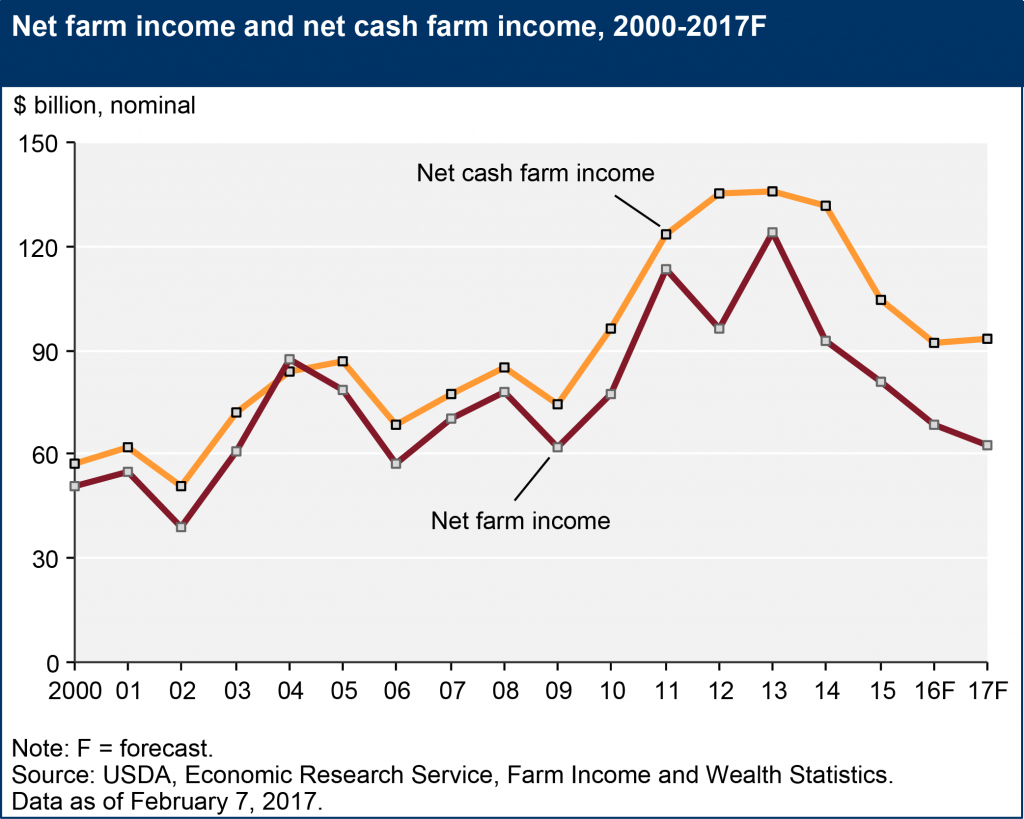Highlights From the February 2017 Farm Income Forecast

Farm sector profitability measures are mixed for 2017. A narrow cash-based measure, net cash farm income, is forecast to rise by $1.6 billion to $93.5 billion from the 2016 value, an increase of 1.8 percent. In contrast, net farm income is forecast to decline by 8.7 percent to $62.3 billion, the fourth consecutive year of declines after reaching a record high in 2013. The difference between the two profitability measures is expected to increase in 2017 largely due to an additional $8.2 billion in cash receipts from the sale of crop inventories. The net cash farm income measure counts those sales as part of current-year income while the net farm income measure counted the value of those inventories as part of prior year income. If realized, net farm income in 2017 will be the lowest since 2002, in inflation-adjusted terms.
Overall, cash receipts are forecast to remain largely unchanged, with large offsetting changes in dairy receipts—up by $4.7 billion, or 13.7 percent, based on forecast higher prices—and cattle/calf receipts, which are forecast down by $4.5 billion (6.7 percent) based on anticipated lower prices. The forecast for crops is mostly unchanged, with wheat receipts changing most in absolute and percentage terms, falling $1.4 billion (16.6 percent) relative to 2016. Direct government payments are down by $0.5 billion (4.0 percent) to $12.5 billion.
The 2017 forecast for average net cash income for farm businesses is up by 2.2 percent, with the largest increases for farms specializing in cotton (up 34 percent) and dairy (up 47 percent). These strong gains are offset by a forecast drop in net cash farm income for cattle/calf operations (down 12.9 percent).
After declining for 2 consecutive years, the forecast for 2017 total production expenses is flat, with farm-origin expenses (including feed, livestock, and seed) down 2.6 percent as a group. Manufactured input expenses were more mixed, with fertilizer group expenditures forecast down by 9.1 percent and fuel/oil expenses up by 13.1 percent. Labor costs are also forecast to rise 5.4 percent in 2017.
Farm asset values are forecast to decline by 1.1 percent in 2017, and farm debt is forecast to increase by 5.2 percent. Farm sector equity, the net measure of assets and debt, is forecast down by $51.2 billion (2.1 percent) in 2017. The decline in assets reflects a 0.3-percent drop in the value of farm real estate, as well as declines in the remaining categories. The rise in farm debt is driven by higher real estate debt (up 7.3 percent). Financial liquidity measures, including working capital, are forecast to weaken in 2017, as are solvency measures such as the debt-to-asset ratio. The debt-to-asset measure is now above its average over the previous ten years.
Get the 2017 forecast for farm sector income or see all data tables on farm income indicators.

Median Income of Farm Operator Households Expected to Rise 3 Percent in 2017
The median income of U.S. farm households increased steadily over 2010-14, reaching an estimated $81,637 in 2014. After dipping in 2015 to $76,735, median household income is forecast to rise over the next 2 years, reaching an expected $79,733 in 2017. Median farm income earned by farm households is estimated to be -$765 in 2015 and forecast to drop to -$1,328 in 2016 and -1,437 in 2017. In recent years, slightly more than half of farm households have lost money on their farming operations each year; most of these households earn positive off-farm income—median off-farm income is forecast to increase 6.7 percent over the next 2 years, from $67,500 in 2015 to $72,022 in 2017. (Because farm and off-farm income are not distributed identically for every farm, median total income will generally not equal the sum of median off-farm and median farm income.)
Get the 2017 forecast for farm household income or see the Farm Household Income and Characteristics data product tables for financial statistics of farm operator households.

See also
- Farm Sector Income and Finances for a discussion of the full farm sector income forecast
- Farm Household Well-being for a discussion of the farm household income forecast
- Farm Income and Wealth Statistics for the complete 2017 farm income forecast data and full history of U.S. and State farm sector estimates.
- Charts and Maps About Your State, Charts and Maps of U.S. Farm Sector Balance Sheet Data, and Charts and Maps of U.S. Farm Income Statement Data for farm sector data visualizations.
- Farm Household Income and Characteristics for data related to farm household income and characteristics.
- ARMS Farm Financial and Crop Production Practices data that underpin the farm income forecast and estimates.










